The Current View
A lengthy downtrend in sector prices had given way to a relatively stable trajectory after mid 2013 similar to that experienced in the latter part of the 1990s and first few years of the 2000s.
The late 1990s and early 2000s was a period of macroeconomic upheaval during which time sector pricing nonetheless proved relatively stable.
Relative stability suggests a chance for companies genuinely adding value through development success to see their share prices move higher. This was the experience in the late 1990s and early 2000s.
Still vulnerable cyclical conditions were aggravated in the second half of 2015 by a push from investors worldwide to reduce risk. Sector prices were pushed to a new cyclical low. These conditions were reversed through 2016 and 2017 although sector prices have done little more than revert to the 2013 levels which had once been regarded as cyclically weak.
With a median decline in prices of ASX-listed resources companies through the cycle of 89%(and 30% of companies suffering a decline of more then 95%), the majority of stocks remain prone to strong 'bottom of the cycle' leverage in response to even slight improvements in conditions.
Has Anything Changed?
The strength of the US dollar exchange rate since mid 2014 had added an unusual weight to US dollar prices. Reversal of some of the currency gains has been adding to commodity price strength through 2017.
Signs of cyclical stabilisation in sector equity prices has meant some very strong ‘bottom of the cycle’ gains.
Funding for project development has passed its most difficult phase with the appearance of a stronger risk appetite.

Resource Sector Weekly Returns

Market Breadth Statistics
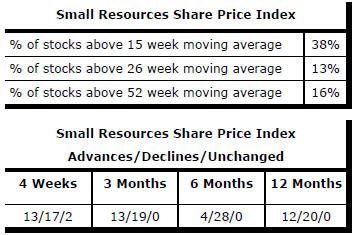
52 Week Price Ranges

Equity Markets

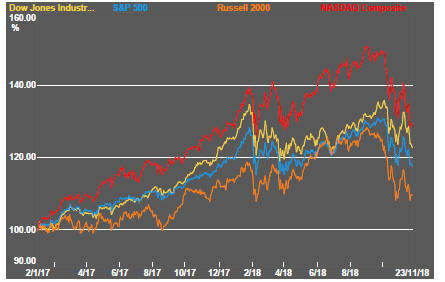
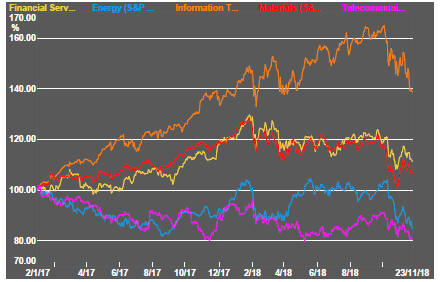

Big day-to-day and intraday swings in equity prices remained a feature of markets in the past week.
An 11% fall in crude oil prices rattled equity markets as inferences were drawn from the decline about global growth and as the market felt the impact on the share prices of oil related companies.
China-US trade tensions and worries about the extent to which the US Federal Reserve will raise interest rates also continued to affect US equity prices adversely.
The market is looking for clarification on both these points in coming days with Federal Reserve chairman Jerome Powell due to speak in New York and as G20 leaders meet in Argentina.
The impact of neither market influence is likely to be resolved fully, leaving open the prospect of continuing market volatility in response to periodic comments about likely outcomes.
Once again in the past week, there were conflicting statements about trade policy from the US administration. Multiple statements from Fed governors are also prone to add volatility rather than contribute clarity about the direction and size of future policy steps.
Resource Sector Equities





Mining sector equities reflected the broader equity price trends, with net falls in prices among the market leaders. The largest as well as the middle range stocks in the sector have largely given up any gains which had been accumulated in the past year.
Prices of exploration stocks were marginally higher in the past week but gains among these companies have come from a very depressed base after a net double-digit fall over the past 12 months.
Gold stocks have been relatively stable, posting a modest gain for the week and a similarly small gain for the past year as a whole.
Interest Rates




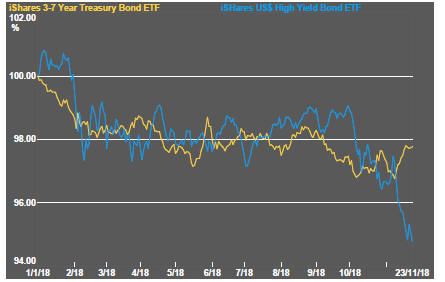
The US 10 year bond yield edged lower as investors have reacted to emerging views about inflation outcomes and revised expectations about how aggressively the Federal Reserve will pursue interest rate rises in the year ahead.
While equity markets have been highly responsive to news about the likely trajectory of interest rates, government bond yields have shown little reaction.
The bond market continues to employ a different view about interest rates than the plot of rate rises released by the Federal Reserve and which is intended to summarise the views of the Fed governors.
Low grade corporate debt yields continue to rise against the trend of government debt in an ominous sign for the capital-hungry mining industry that funding conditions are deteriorating.
Exchange Rates










The US dollar has retained an upward bias reflecting relatively strong US growth, rising demand for less risky assets and the prospect of US interest rates rising more quickly than in other advanced economies.
Sterling did not respond as positively as traders had once expected to a Brexit agreement but, with a broad consensus that Prime Minister May does not have sufficient support in the House of Commons for the agreement she has reached, the currency is not pricing a successful conclusion to the negotiations.
Developing country currency pressures have eased in recent weeks once prices had adjusted to the greater perceived emerging market risks. Conditions in individual markets holding back growth as well as perceived systemic risks across the sector persist.
Commodity Prices
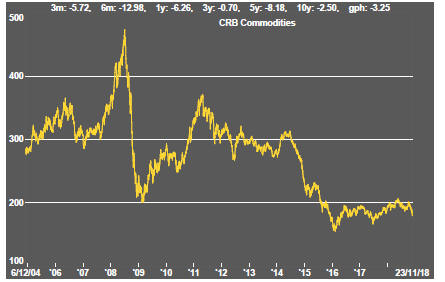
The general upswing in commodity prices since mid 2017 had been given added impetus by stronger crude oil prices.
Subsequently diminished momentum, with added impetus from a reversal of crude oil prices, has left prices within the bounds of a cyclical trough, albeit at the upper end.
The flip side of the benefits for commodity producers and exporters of higher commodity prices is the cost pressure being experienced by users of agricultural and raw material commodities. Reporting companies have been suggesting this as a source of margin compression.
Business surveys closely watched by central banks are showing signs of upward pressure on selling prices as a result of higher raw material prices.
Gold & Precious Metals





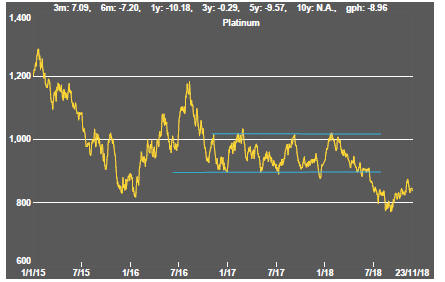

Gold prices did not change significantly during the week although precious metal prices, more generally, were weaker.
Stronger government bond prices should have supported higher gold prices but the response proved muted. The gold price has not been as sensitive to yield changes in recent months as it had been historically.
The disparate price performance among the various precious metals remains evident with silver prices to face the strongest headwinds.
Fluctuations in silver prices have proven a clearer guide to movements in the prices of junior gold miners than gold bullion prices suggesting different mindsets among these operating within the riskier ends of precious metal investments.
Nonferrous Metals



Daily traded nonferrous metal prices were generally lower during the week. Aluminium and copper prices increased slightly. Nickel prices suffered a large loss with less significant falls in tin and zinc prices.
All the main London traded prices are now below the levels at which they started in 2018 with tin, for so long the laggard, now showing the best relative performance over the year to date.
The copper price has been at odds with higher bond yields which normally signal strengthening inflation and growth. The normally growth sensitive metal price appears to be taking a back seat as an indicator of market conditions for the time being. Its holding pattern may be suggestive of indecision and the possibility of a future break in direction as the global growth trajectory becomes clearer.
Bulk Commodities

Chinese economic growth reports show the national economy meeting its targets, as one would expect for a centrally planned economy, but without any overt signs of upside risk. The tariff fight with the USA is beginning to take a toll on activity rates in an economy with a bias toward less strong growth in the years ahead.
Reported GDP growth in the September quarter was consistent with official forecasts although hitting the targets is becoming more challenging by the year.
The latest manufacturers purchasing managers index for China, measuring conditions in October, implied continuing slowing in momentum with some evidence of the Sino-US trade dispute taking a toll on conditions.
Growth was slowing in any event leading the Chinese authorities to once again resort to pumping up the economy through more infrastructure spending.
Iron ore prices slipped lower after recording gains over the past several weeks, although a large fall in steel prices had intimated that the US-China trade dispute was having an effect on the industry with possible repercussions on iron ore prices.
Coal prices slipped further during the week, albeit after some strong gains. China reported growth in coal output between September and August and over the year to September with plans to open new capacity proceeding as the country switches to larger more efficient sources of coal production.
Oil and Gas



Crude oil prices slumped dramatically as concerns about demand growth loomed and supply constraints appeared looser. OPEC had raised the alarm by cutting back its 2019 crude oil demand forecast.
A CIA report implicating the Saudi crown prince in the murder of journalist Jamal Kashoggi appeared to give US President Donald Trump some added leverage in his efforts to have the Saudi's keep a lid on prices.
OPEC, and the Saudi government, has also been losing control of the market as US and Russian production have become more significant.
Reimposition of Iranian economic sanctions by the US government had put upward pressure on prices but the US government itself provided some relief by announcing that it would not apply sanctions against some importers of Iranian oil, at least for the time being.
US production, in any event, continues to rise and is now matching output from Russia and Saudi Arabia. Texas alone is positioned to be the third largest producer after Russia and Saudi Arabia. Export infrastructure limitations may be the greatest impediment to US production having a greater effect on international energy prices.
The prices of oil related equities have reacted negatively, as one would expect, to the weakening market conditions with added pressures coming from slumping equity prices during October.
Battery Metals
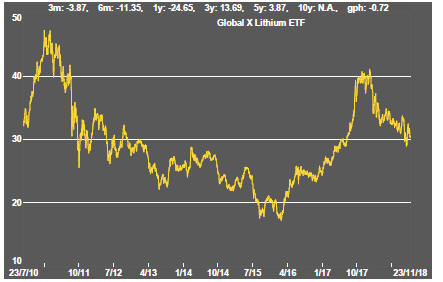
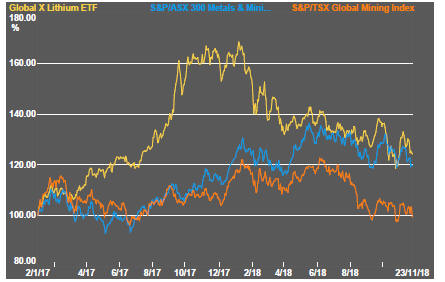
Eighteen months of rising lithium-related stock prices have given way to a prolonged period of market reassessment as a lengthy pipeline of potential new projects has raised the prospect of ongoing supplies better matching expected needs.
Potential lithium producers have been able to respond far more quickly to market signals than has been the case in other segments of the mining industry where development prospects have been slowed by reticence among financiers to back development.
Movements in lithium related equity prices had been aligned more closely with overall sector equity prices in recent weeks with the lithium stocks tending to display a greater leverage to changes in market sentiment about the mining sector.
The median fall from their 52 week high within a large sample of 80 Australian and Canadian listed stocks with lithium exposure, mostly with an exploration orientation, has exceeded 50%. Every one of the stocks is trading below its peak price from the last year.

Battery metals remain a focal point for investors with recent attention moving to cobalt and vanadium.
Doubts about political conditions in the Democratic Republic of the Congo (and instances of Ebola) have added a dimension to cobalt prices lacking in other metals caught up in the excitement over the longer term impact of transport electrification. Short term market tightness relating to non-battery demand is easing.
In the longer term, cobalt is the most vulnerable of the battery related metals to substitution with high prices likely to stimulate research in that direction.
A spokesperson for Panasonic, manufacturer of batteries for Tesla motor vehicles, has been quoted as saying that the company intends to halve the cobalt content of its batteries because of uncertainties over supply although, offsetting such a move, will be the rapid increase in the number of units produced.
Uranium


The uranium sector is in the midst of forming a prolonged cyclical trough as market balances slowly improve. Power utilities have been reluctant to re-enter the market for contracted amounts of metal to meet longer term needs although an upward bias in prices is now evident.
The effect of an announcement by Canadian producer Cameco to extend the duration of its previously implemented production cut gave the market a very slight but quickly lost lift.
Slightly higher equity prices from time to time, in the hope of improved conditions, have not been sustained but could be repeated as speculation about improved future demand ebbs and flows.
News that the Kazakhstan government intends to list its state owned uranium producer, also the world's largest producer, may suggest greater responsiveness to market conditions and less emphasis on production to maximise government revenue.

The Steak or Sizzle? blog LINK contains additional commentary on the best performed stocks in the sector and the extent to which their investment outcomes are underpinned by a strong enough value proposition to sustain the gains.


